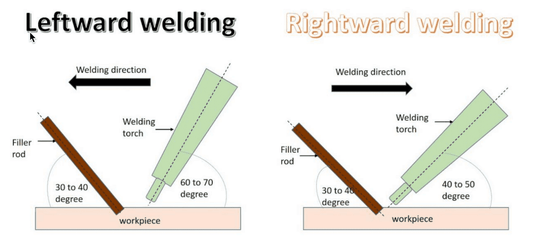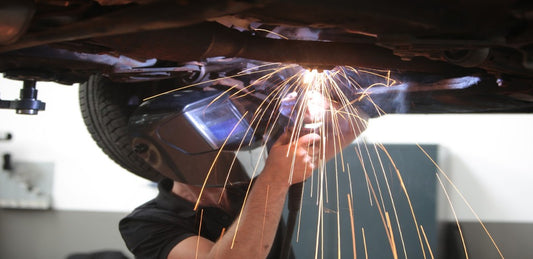Two Types of Titanium Welding Process

Image Credit: Rime GmbH
Tungsten Inert Gas / Gas-tungsten arc welding Introduction
TIG welding, also known as GTAW(Gas Tungsten Arc Welding), is the most used method for welding titanium. It is precision and ability to create significant welds. The welding process utilizes non-consumable electrodes. The electrode transfers electrical current. The electrode creates an arc between the two pieces of metal being welded. The arc melts the metal, enabling it to fuse upon cooling. You can use shielding gas to prevent welding puddles of external contamination. The contamination can lead to weakness and poor-quality welds.
TIG welding is a common method for titanium welding. You can TIG weld on workpieces up to 3mm thickness without filler material. For thicker workpieces, it is necessary to use filler rods to ensure welding joints are strong and durable.

Image Credit: Rime GmbH
Metal Inert Gas / Gas-Metal Arc Welding Welding Introduction
MIG welding, also known as Gas-Metal Arc Welding Welding (GMAW), is used in automotive and fabrication industry. It is relatively fast and easy to learn. Unlike TIG welding, MIG welding uses a continuously feeding consumable electrode. A welding gun is connected to a power source that provides the electric current to create the arc. During welding, a shielding gas is also fed through the welding gun. The gas shields the weld to protect the pool and electrode from the air to avoid contamination.
MIG welding is a common method for welding titanium with a thickness greater than 3 mm. If you use MIG welding on titanium whose thickness is less than 3 mm, the metal is likely to be burned. MIG welding is an economical option for titanium with a thickness of 12.7mm and above.
Welding Processes
1. TIG welding titanium
TIG welding is the welder's first choice for welding titanium. TIG welding is different from other welding processes. It uses a tungsten electrode, filler wire, and shielding gas. But, TIG welding titanium is very different from welding other metals such as stainless steel. When welding titanium, pure argon shielding gas protects the molten weld pool.
The back side of the welding must also be shielded because it remains hot enough to react with oxygen and other atmospheric components. It is essential when working with thin or tube sections. Failure to properly cover the weld can lead to contamination and weakened welds.
Using 99.999% pure argon as a shielding gas during welding is essential. This gas provides the best protection against atmospheric contamination. Even slight impurities in the Argon gas can result in discoloration.
For TIG welding titanium, use a DC straight polarity (DCSP) with a conventional power supply. A high-frequency (non-touch) arc-starting system should prevent the tungsten electrode from touching the titanium workpiece. Pulse TIG welding can help control heat and improve arc stability and penetration.
TIG welding provides superior control to the welder over other welding processes. It allows for precise management of heat input and the molten weld pool. TIG welding also allows for controlling the current from a distance. It has a timer for post-flow and can start an arc using high frequency without touching.
2. MIG welding titanium
To meet a more productive titanium welding process demand, MIG welding can be a viable option. MIG welding is different from TIG welding. It uses titanium filler rods that keep feeding while welding. The arc happens between the wire and the workpiece. This results in a much higher weld deposition rate compared to TIG welding.
Like TIG, MIG welding also needs a gas to shield the molten weld pool and hot weld metal behind it. Helium is used as shielding gas in MIG welding, unlike TIG welding. The argon can lead to an unstable welding arc during MIG welding.
When welding titanium, the layer of titanium oxide on the workpiece can release electrons, causing a phenomenon called wandering. It causes the welding arc to wander and leads to defective welding. We can use a high-frequency micro-oscillation on the wire's contact tip to avoid it.
When MIG welding titanium, reverse polarity (DCRP) is used, a remote-controlled contactor lets you break the arc without removing the torch from the cooling weld metal, keeping the inert gas shielding intact. Features like foot-operated control for current and contactors, high-frequency arc starting, and gas timers are also desirable.
It's important to note that MIG welding titanium requires high skill and experience due to its unique properties. If you need to become more familiar with welding titanium, it's recommended to practice on scrap or seek professional training.
Welding Torch Selection
For TIG welding, it is recommended to use a torch with water-cooled. The ceramic cup and a gas lens are 19mm. Sometimes, a larger 25.4mm cup may be necessary for MIG welding. Thoriated tungsten electrodes containing 2% thoria are recommended for TIG welding. Using pointed electrodes with end-blunted tips can help control arc characteristics. The electrodes need to carry the requested current. The smaller, the better.
No comments









0 comments